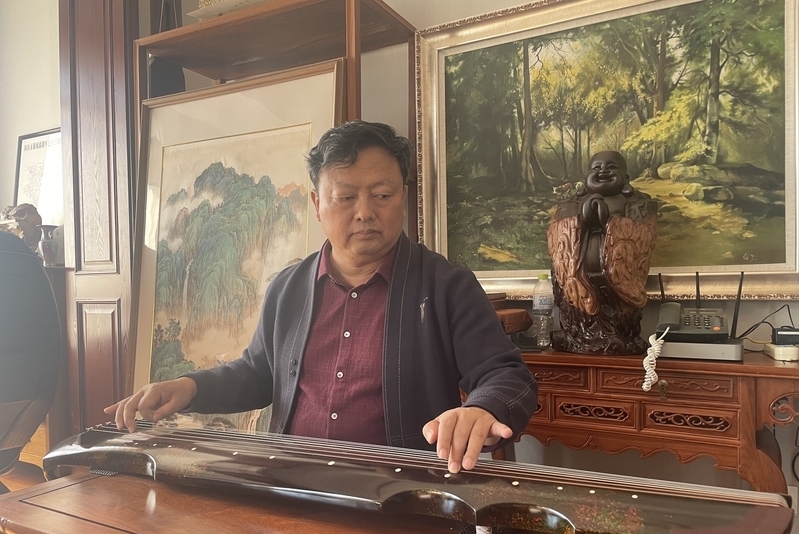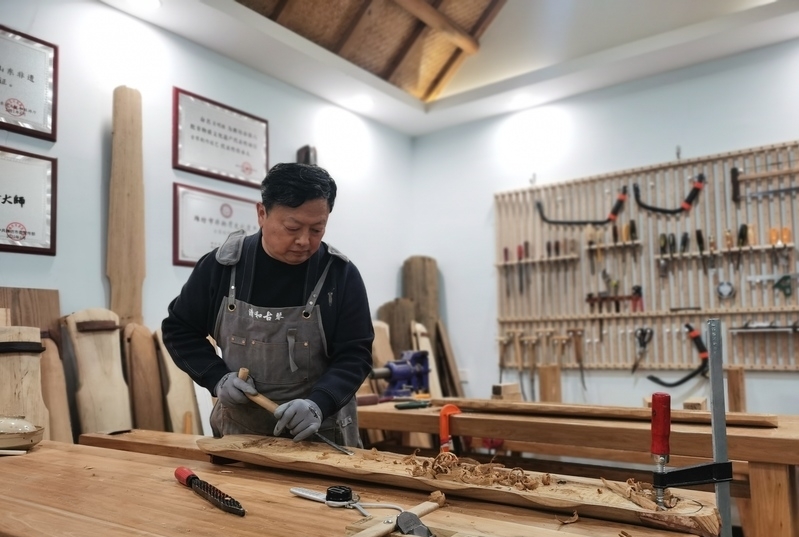Xiao Mingsheng, inheritor of Guqin making skills: adhere to the craftsman's feelings to inherit the ancient sound of thousands of years
Xiao Mingsheng, 57, is not only a representative inheritor of Guqin intangible heritage projects, but also a promoter and educator of Guqin culture. He gave full play to the advantages of intelligent manufacturing in guqin production techniques, introduced modern precision machining technology and numerical control technology, and promoted the creative transformation and innovative development of Guqin culture. He was awarded the fourth batch of honorary title of "Weifang Folk Art Master".

Guqin, one of the "four Arts" of Chinese traditional culture, is a traditional Chinese musical instrument. To make the guqin, which is gracefully called the mojo. Nowadays, there are not many people who can play the guqin and there are even fewer people who know how to have guqin mojo. The people who can both play and master guqin mojo are rare. Xiao Mingsheng was born in 1965 and worked in Liaocheng University after graduating from the Department of Chemistry. He took a temporary post in Weichai in 2000 and then worked in Weichai until now.
Talking about the origin of Guqin, Xiao Mingsheng opened his mouth. As a child, he loved vocal music. When he was working in Liaocheng University, a colleague invited him to listen to guqin playing. "As soon as the guqin sounded, I was immediately shocked by the sweet sound. I had only heard Guqin playing on the radio before, but this was the first time I heard it up close." Xiao said the second time he heard the guqin was when he watched the opening ceremony of the Beijing Olympics in 2008. The music of the thousand-year-old guqin shook the audience, which made him love it more.
Since then, Xiao has learned to play the piano. A guqin was very expensive, so he tried to make it out of two wutong boards. Although it could make sound, it was obviously not successful by today's standards. "The chopped qin is an intangible cultural heritage project. There are many techniques and know-how. To do it well, you have to learn." Xiao Mingsheng has been to Shanghai, Xi 'an, Nanjing, Yangzhou and other places, visited many teachers, some teach and some do not teach, but there is not a vain trip, he just watch others do. Later, he formally learned the skills of the qin mookist by Zhu Zhenghai, the inheritor of the intangible cultural heritage of Guangling Qin School. Then he learned some secrets of the qin mookist by Mr. Tian Shuangkun, the famous Chinese master of guqin maker, and his skills became more exquisite.

In the high-tech zone Jinma road and health east Street intersection east Xiao Mingsheng guitar studio, there are a lot of his homemade guqin. Xiao Mingsheng told reporters, Guqin production skills are very complex, the most critical there are four steps. The first is to select materials, choose no joint no scar soft and hard moderate old fir or tung. The next step is the grooving, which is also the most core step. The third step is to repair the paint, which takes the longest time. Finally, it is to finalize, after the previous steps, to place more than a year and a half to stabilize the wood state, to reduce cracking deformation.
"The people who make the instrument and the sound strive for perfection and perfection. They never feel satisfied when they have made it. They always hope that the next one may be better than this one, but they never reach perfection." Xiao Mingsheng said that the performance of the guqin is very strong. It not only has a wide vocal range and beautiful timbour, but also is neutral, peaceful, clear and distant. Both the performance and production of the guqin contain the excellent traditional Chinese culture and the golden mean of Confucian culture.
In order to better inherit the art of Guqin, Xiao Mingsheng promoted the activities of introducing intangible cultural heritage into the campus. Weifang Engineering Vocational College has successively built "Guqin Cultural Museum", "Luban Workshop" and "intangible cultural heritage Space", etc. He also opened Guqin major and intangible cultural heritage courses and cultivated 7 inheritors at or above the county level. The "Guqin Making Skills" project he is in charge of has been selected into the sixth batch of representative projects of intangible cultural heritage in Weifang City. The original four new guqin patterns of "Qinghe", "Qingquan", "Qingyun" and "Qinghui" have won the national appearance design patent.
In addition to making guqin by hand, Xiao Mingsheng also led the team to constantly introduce modern technology, greatly reducing the time of making guqin, improving the accuracy, and constantly promoting the development of guqin making skills. When it comes to the future plan, he hopes to let more people learn how to make guqin, constantly improve the overall skill level of guqin making, and truly let guqin and guqin culture carry forward.
 渝公网安备 50010702504639号
渝公网安备 50010702504639号